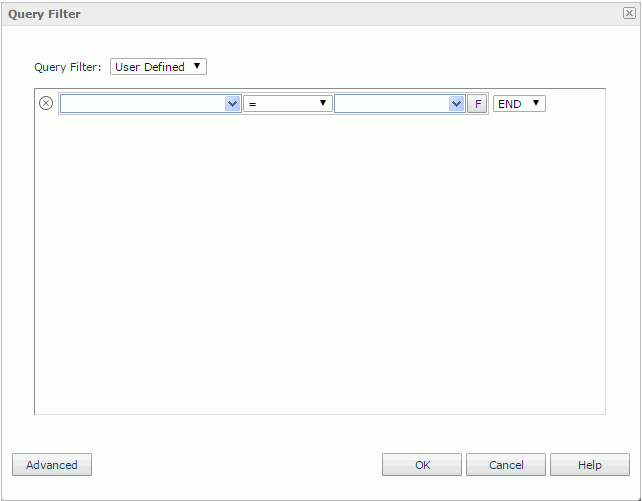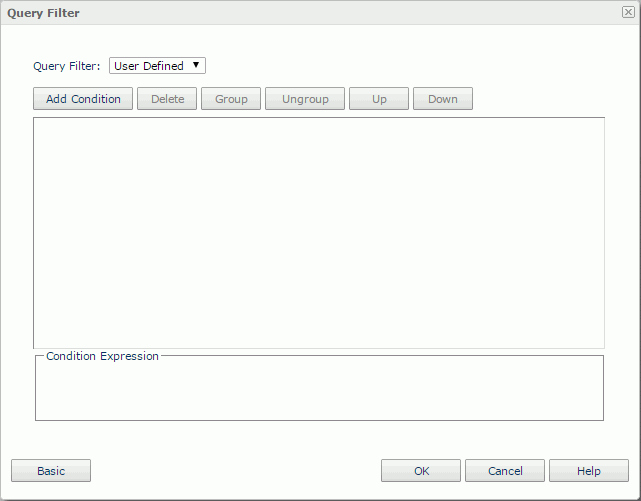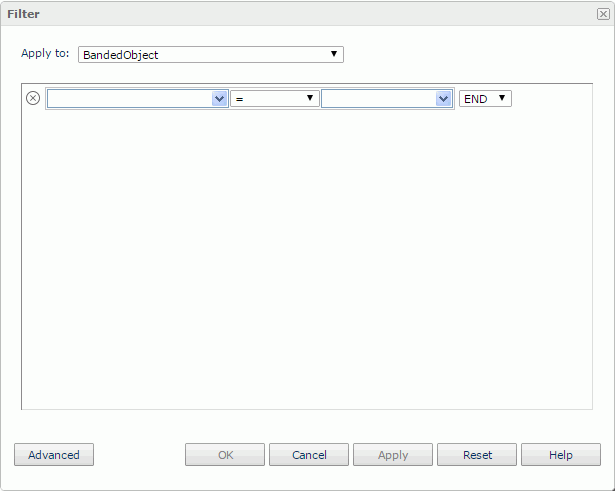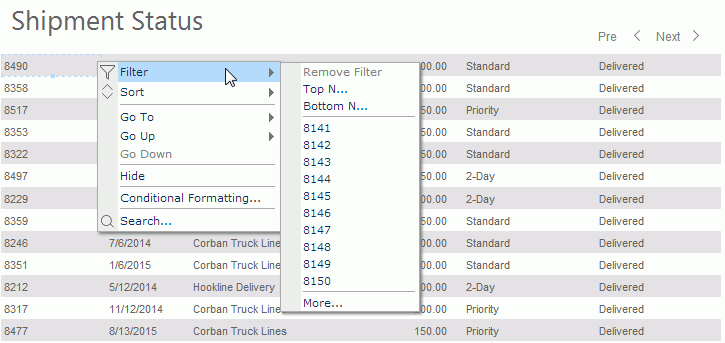Applying Filters
You can apply filters to a page report so as to narrow down the data displayed in the report. The filters can be applied to the business views used by data components such as banded objects, tables, crosstabs and charts in the report, or to the data components themselves.
Below is a list of the sections covered in this topic:
Applying Filters to Business Views
For data components created on business views or converted to use business views in a page report, you can apply filters to the business views they use to narrow down the data scope of the business views. Filters for business views are defined into two categories in Page Report Studio: predefined filters and user-defined filters. As the name suggests, predefined filters are defined on business views in advance in Logi JReport Designer, and user-defined filters are created on business views while they are used in Page Report Studio.
Business view filters are defined on the component level in Page Report Studio, which means each time you create a component, you can apply a filter to the business view it applies without affecting other components based on the same business view.
A Logi JReport Live license for Logi JReport Server is required in order to use this feature. If you do not have the license, contact your Logi Analytics account manager to obtain it.
Applying a Filter to the Business View for a Data Component
To apply a filter to the business view a data component uses:
- Select the component by selecting anywhere in it, and then selecting the icon
 at the upper left corner of the component.
at the upper left corner of the component. - Select Menu > Report > Query Filter, or right-click the component and select Query Filter from the shortcut menu to display the Query Filter dialog.
All the predefined filters of the business view the data component uses are listed in the Query Filter drop-down list. Choose the one you want to apply. If you want to further edit the filter, select the Edit button and then redefine the filter as required. The edited filter will then be saved as a user-defined filter to the business view.
If you prefer to define a filter on your own, select User-Defined from the Query Filter drop-down list, then define the filter according to your requirements.
There are basic and advanced modes of the dialog for you to define either simple expressions or complex expressions.
- To define a filter using simple expressions:
- Make sure the dialog is in the basic mode.

- From the field drop-down list, select the field on which the filter is based.
- From the operator drop-down list, set the operator with which to compose the filter expression.
- The values of the specified field are available in the value drop-down list. Select the required one by which to filter the field. If you want to filter the field by another field, select
 next to the value drop-down list, then the fields and parameters of the same data type as the specified field and the special field User Name will be available in the drop-down list. Select the required one to use. To go back to filter the field by value, select
next to the value drop-down list, then the fields and parameters of the same data type as the specified field and the special field User Name will be available in the drop-down list. Select the required one to use. To go back to filter the field by value, select  . You can also enter the value manually in the text box and when you type the value, if multiple values are required, they should be separated with ",", and if "," or "\" is contained in the values, write it as "\," or "\\".
. You can also enter the value manually in the text box and when you type the value, if multiple values are required, they should be separated with ",", and if "," or "\" is contained in the values, write it as "\," or "\\". - If you want to add another condition line, from the logic operator drop-down list,
- To add a condition line of the AND relationship with the current line, select AND, then define the expression as required.
- To add a condition line of the OR relationship with the current line, select OR, then define the expression as required.
Repeat this to add more condition lines if required. To delete a condition line, select
 on its left.
on its left.
- Make sure the dialog is in the basic mode.
- To define a filter using complex expressions:
- Switch the dialog to the advanced mode.

- Select the Add Condition button to add a condition line.
- From the field drop-down list, select the field on which the filter is based.
- From the operator drop-down list, set the operator with which to compose the filter expression.
- The values of the specified field are available in the value drop-down list. Select the required one by which to filter the field. If you want to filter the field by another field, select
 next to the value drop-down list, then the fields and parameters of the same data type as the specified field and the special field User Name will be available in the drop-down list. Select the required one to use. To go back to filter the field by value, select
next to the value drop-down list, then the fields and parameters of the same data type as the specified field and the special field User Name will be available in the drop-down list. Select the required one to use. To go back to filter the field by value, select  . You can also enter the value manually in the text box and when you type the value, if multiple values are required, they should be separated with ",", and if "," or "\" is contained in the values, write it as "\," or "\\".
. You can also enter the value manually in the text box and when you type the value, if multiple values are required, they should be separated with ",", and if "," or "\" is contained in the values, write it as "\," or "\\". - To add another condition line, select the Add Condition button and define the expression as required. Then, select the logic button until you get the required logic to specify the relationship between the two filter expressions. The logic can be AND, OR, AND NOT, or OR NOT.
- Repeat the above steps to add more condition lines if necessary.
To group some conditions, select them and select the Group button, then the selected conditions will be added in one group and work as one line of filter expression. Conditions and groups together can be further grouped. To take any condition or group in a group out, select it and select Ungroup. It is the equivalent of adding parenthesis in a logic expression.
To adjust the priority of a condition line or a group, select it and select the Up or Down button.
To delete a condition line or a group, select it and select the Delete button.
- Switch the dialog to the advanced mode.
- To define a filter using simple expressions:
- Select OK and the specified filter will be applied to the business view. Only data that meet the filter condition are fetched from the business view and displayed on the data component.
If the special field User Name is used in the filter condition, the user name used to log onto Logi JReport Server will be applied to compose the filter expression; if a parameter is used, after selecting the OK button you will be prompted to specify the parameter value to dynamically define the filter condition.
You can also apply a filter to the business view a data component uses in the Query Filter screen of the report wizard while creating the data component.
Filtering the Data Components in a Report
When applying filters to the data components themselves in a page report, there are the following ways you can take: using the Filter dialog, using shortcut menu, or using filter controls.
To set the filter condition using the Filter dialog:
- Select Menu > Report > Filter, or the Filter button
 on the toolbar. The Filter dialog appears.
on the toolbar. The Filter dialog appears.

- From the Apply to drop-down list, select the data component in the report to which you want to apply the filter.
Tip: For page reports created in Logi JReport Designer, the default selected data component and available data components in the Apply to drop-down list are determined by the Default for Filter and Invisible for Filter Dialogs properties of the components.
- Define the filter using either simple or complex filter expressions. Filtering by field is not supported here.
- Select OK to make the filter take effect and return to the report.
To set the filter condition using shortcut menu:
You can use filter-related commands on the shortcut menu to filter the data in a banded object or table. To do this, point to any value of a field other than the group-by field by which you want to filter data, then right-click to show the shortcut menu. You will see the Filter item which provides a submenu containing the following commands:

- Remove Filter
This command is enabled after you have applied filtering on the field. You can select it to remove the filter ever defined on it. - Top N
Shows the Top N dialog with which you can filter the field to display only its top N values. - Bottom N
Shows the Bottom N dialog with which you can filter the field to display only its bottom N values. - Field values
"Field values" is not the name for a command on the Filter submenu, but represents some items which are the values of the field you right-click on. Select a value and the field will be filtered to show only the specified value. - More
This command is enabled if the Filter submenu cannot list all values of the specified field. When it is enabled, selecting it brings up the Select Values dialog. Select one value in the dialog and the field will be filtered to show only the selected value.
After a filter is applied using the Filter shortcut menu, if you open the Filter dialog you can find that the corresponding filter expression displays in the dialog.
Tip: You can customize the following filter-related features for a page report using Logi JReport Designer:
- Set the Bind Column property for labels in banded objects or tables to enable the Filter shortcut menu on the labels, and show the filter button beside the labels which provides a filter list containing All, Top N, Bottom N, Custom Filter, the field values and More (if there are too many distinct values for the bound field) for easy filtering.
- Customize the items available on the Filter submenu of a field or label with the Filter Options property.
- Specify the default selected component and available components in the Apply to drop-down list of the Filter dialog via the Default for Filter and Invisible for Filter Dialogs properties of the components.
 Previous Topic
Previous Topic